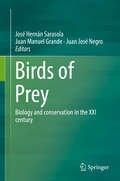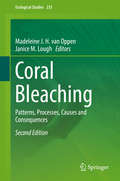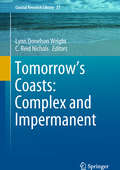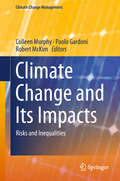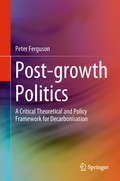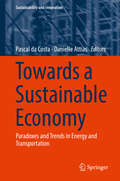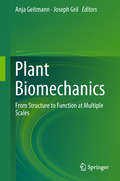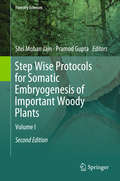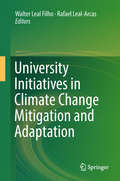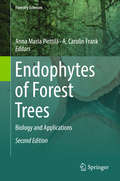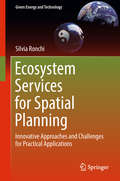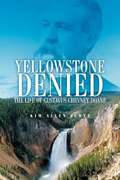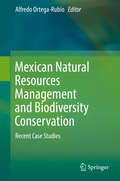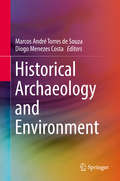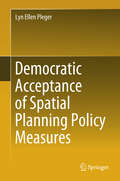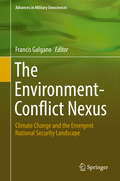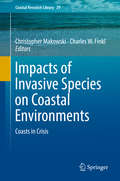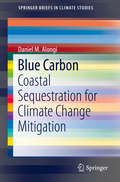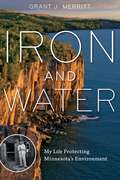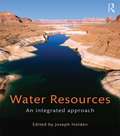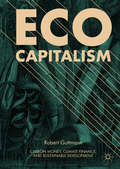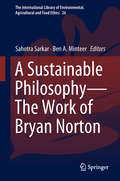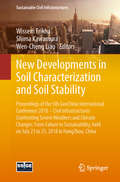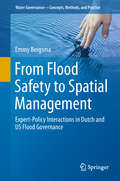- Table View
- List View
Birds of Prey: Biology and conservation in the XXI century
by José Hernán Sarasola Juan Manuel Grande Juan José NegroThis book will provide the state-of-the-art on most of the topics involved in the ecology and conservation of birds of prey. With chapters authored by the most recognized and prestigious researchers on each of the fields, this book will become an authorized reference volume for raptor biologists and researchers around the world.
Coral Bleaching: Patterns, Processes, Causes and Consequences (Ecological Studies #233)
by Madeleine J. van Oppen Janice M. LoughOne of the most serious consequences of global climate change for coral reefs is the increased frequency and severity of mass coral bleaching events and, since the first edition of this volume was published in 2009, there have been additional mass coral bleaching events. This book provides comprehensive information on the causes and consequences of coral bleaching for coral reef ecosystems, from the genes and microbes involved in the bleaching response, to individual coral colonies and whole reef systems. It presents detailed analyses of how coral bleaching can be detected and quantified and reviews future scenarios based on modeling efforts and the potential mechanisms of acclimatisation and adaptation. It also briefly discusses emerging research areas that focus on the development of innovative interventions aiming to increase coral climate resilience and restore reefs.
Tomorrow's Coasts: Complex and Impermanent (Coastal Research Library #27)
by Lynn Donelson Wright C. Reid NicholsThis book is intended as a conceptual roadmap to show how some of the numerous pieces of complex coastal systems intersect and might interact under changing future environmental regimes. It is addressed to a non-technical but environmentally literate audience that includes the lay public, policy makers, planners, engineers and academics interested in the causes and consequences of global changes as they are likely to affect coastal systems. The book also outlines some strategies for anticipating and responding to the challenges that lie ahead. The purpose is not to offer a technical treatise on how to build better numerical models or to provide the cognoscenti with new scientific details or theories. Quite on the contrary the authors aim to provide a holistic, easy-accessible overview of coastal systems and therefore use a writing style that is non-technical, nonmathematical and non-jargonized throughout. Wherever scientific terms are required to avoid ambiguity, a clear and simple definition is presented and those definitions are repeated in the glossary. The authors aim to communicate with all who care about the future of coastal environments. In Part 1, they present some underlying general “big picture” concepts that are applicable to coastal processes and coastal change worldwide. Part 2 reviews some of the more important physical, ecological and societal causes and outcomes of coastal change. A selection of case studies of some prominent and highly vulnerable coastal regions is presented in Part 3. Some strategies for facilitating and supporting collaboration among the global scientific community to enhance future coastal resilience are outlined in Part 4.
Climate Change and Its Impacts: Risks and Inequalities (Climate Change Management)
by Colleen Murphy Paolo Gardoni Robert McKimResponding to a need for a deeper and more nuanced understanding of the consequences of climate change, this book brings experts in climate science, engineering, urban planning, and conservation biology into conversation with scholars in law, geography, anthropology and ethics. It provides insights into how climate change is conceptualized in different fields. The book also aims to contribute to developing successful and multifaceted strategies that promote global, intergenerational and environmental justice. Among the topics addressed are the effects of climate change on the likelihood and magnitude of natural hazards, an assessment of civil infrastructure vulnerabilities, resilience assessment for coastal communities, an ethical framework to evaluate behavior that contributes to climate change, as well as policies and cultural shifts that might help humanity to respond adequately to climate change.
Post-growth Politics: A Critical Theoretical and Policy Framework for Decarbonisation (Green Energy and Technology)
by Peter FergusonThis book uses a critical political economy approach to develop an historically and politically grounded set of strategies for states to move toward a post-growth, decarbonised global economy. It begins by examining the social and ecological costs of and limits to economic growth and determines that significant decarbonisation of the global economy can only be achieved if conventional growth-based economies are replaced by an alternative post-growth economy.Set apart from many other works in the field by its critical political economy approach to policy development, this book offers the reader three distinctive features. First, it places the analysis in historical context in order to demonstrate how the global political economy is constantly changing with respect to distributions of wealth, power and fundamental norms, and explores how states might harness and transform these contingent patterns in a post-growth direction. Second, the book is not only concerned with developing and advocating post-growth policies, but also with how these measures can be incorporated into the high-level domestic and international strategies pursued by states to ensure their political legitimacy and economic and geopolitical survival. Third, rather than proposing an idealised and politically naïve model of socioecological transformation, the proposed post-growth policy framework is highly cognisant of the geopolitical and international economic pressures facing states and demonstrates how these can be managed in the transition toward a post-growth economy.This book represents an invaluable resource for policymakers, academics, activists and students wishing to study or contribute to the transition to a post-growth, decarbonised economy.
Towards a Sustainable Economy: Paradoxes and Trends in Energy and Transportation (Sustainability and Innovation)
by Pascal Da Costa Danielle AttiasThis book provides an interdisciplinary account of how technological advances – mainly in the domains of energy and transportation – contribute to the transformation towards a more sustainable economic system. Drawing on methods from engineering, the management sciences and economics, which it combines in the framework of a systems sciences approach, the book presents qualitative and quantitative studies on government regulation, resources management and firms' strategy. Topics covered include the state-market dilemma of government CO2 emission targets, implications of the electrification of the economy, incentives and coercion in government transport policies, and innovations in the electric vehicle industry.
Plant Biomechanics: From Structure to Function at Multiple Scales
by Anja Geitmann Joseph GrilThis book provides important insights into the operating principles of plants by highlighting the relationship between structure and function. It describes the quantitative determination of structural and mechanical parameters, such as the material properties of a tissue, in correlation with specific features, such as the ability of the tissue to conduct water or withstand bending forces, which will allow advanced analysis in plant biomechanics. This knowledge enables researchers to understand the developmental changes that occur in plant organs over their life span and under the influence of environmental factors. The authors provide an overview of the state of the art of plant structure and function and how they relate to the mechanical behavior of the organism, such as the ability of plants to grow against the gravity vector or to withstand the forces of wind. They also show the sophisticated strategies employed by plants to effect organ movement and morphogenesis in the absence of muscles or cellular migration. As such, this book not only appeals to scientists currently working in plant sciences and biophysics, but also inspires future generations to pursue their own research in this area.
Step Wise Protocols for Somatic Embryogenesis of Important Woody Plants: Volume I (Forestry Sciences #84)
by Shri Mohan Jain Pramod GuptaWorld population is increasing at an alarming rate and this has resulted in increasing tremendously the demand for tree products such as wood for construction materials, fuel and paper, fruits, oils and medicines etc. This has put immense pressure on the world’s supplies of trees and raw material to industry and will continue to do so as long as human population continues to grow. Also, the quality of human diet, especially nutritional components, is adversely affected due to limited genetic improvement of most of fruit trees. Thus there is an immediate need to increase productivity of trees. Improvement has been made through conventional breeding methods, however, conventional breeding is very slow due to long life cycle of trees. A basic strategy in tree improvement is to capture genetic gain through clonal propagation. Clonal propagation via organogenesis is being used for the production of selected elite individual trees. However, the methods are labour intensive, costly, and produce low volumes. Genetic gain can now be captured through somatic embryogenesis. Formation of embryos from somatic cells by a process resembling zygotic embryogenesis is one of the most important features of plants. In 1958, Reinert in Germany and Steward in USA independently reported somatic embryogenesis in carrot cultures. Since then, tremendous progress in somatic embryogenesis of woody and non-woody plants has taken place. It offers a potentially large-scale propagation system for superior clones.
University Initiatives in Climate Change Mitigation and Adaptation
by Walter Leal Filho Rafael Leal-ArcasThis book focuses on the role of higher education institutions in addressing climate change mitigation and adaptation challenges, contributing to the development of this fast-growing field. Further, it includes the results of empirical research and offers ideas regarding on-going and future research initiatives. The contributions also• showcase the research and projects on issues pertaining to climate change at universities from across the globe;• document and promote ideas and experiences acquired in the execution of research projects, especially successful initiatives and best practices; and• introduce methodological approaches and projects that offer a better understanding of climate change across society and economic sectors.The book is structured around two parts: lessons learned from climate change research, education, studies and projects. Each part focuses on mitigation and adaptation respectively, with many responses of the two modalities overlapping.This book is a valuable resource for researchers and practitioners in the fields of environment, human geography, business and economics, as well as academics and students, as it presents education, communication and awareness-raising projects on matters related to climate change at universities in both industrialised and developing countries, often in cooperation with government bodies, NGOs and other stakeholders.
Endophytes of Forest Trees: Biology and Applications (Forestry Sciences #86)
by Anna Maria Pirttilä A. Carolin FrankEndophytes are commonly known as microorganisms, mainly bacteria and fungi, which live inside plant tissues without inducing symptoms. Considering the long-lived trees, endophytes have a fundamental role in preparing their hosts to face extreme weather conditions, drought, heat, cold, and pathogen and herbivore attacks. The current knowledge clearly demonstrates the importance of endophytes in shaping the plant diversity in a forest. Endophytes have an important capacity for biocontrol of forest diseases. Considering endophyte diversity and the range of various compounds and enzymes they can produce, endophytes can be used for various biotechnological applications.
Ecosystem Services for Spatial Planning: Innovative Approaches and Challenges for Practical Applications (Green Energy and Technology)
by Silvia RonchiThe book investigates the relationship between ecosystem services (ES) and spatial planning, and explores potential means of integrating the two concepts to support the decision-making process. In addition, it presents case studies demonstrating the outcomes, limitations, opportunities and further new developments in ES assessment/mapping for planning support. Then it describes the “Restart from Ecosystem Services” (RES) methodology, which is aimed at integrating ES into the planning process using an ecological balance, and at promoting new planning parameters for the transformation areas. RES ensures the inclusion of ES in planning processes using the incremental measures of limiting, mitigating and compensating soil sealing and land take process promoting operational strategies in applying it. The implementation of RES is associated with strategic environmental assessment and provides valuable support in the definition of strategies across the entire planning process, especially for the evaluation of alternative scenarios.
Yellowstone Denied: The Life of Gustavus Cheyney Doane
by Kim Allen ScottFrontier soldier and explorer extraordinaire, Gustavus Cheyney Doane was no stranger to historical events. Between 1863 and 1892, he fought in the Civil War, participated in every major Indian battle in Montana Territory, and led the first scientific reconnaissance into the Yellowstone country. He was always close to being at the right place at the right time to secure lasting fame, yet that fame eluded him, even after his death. Finally, Kim Allen Scott rescues Doane from obscurity to tell the tale of an educated and inventive man who strove in vain for recognition throughout his life. Yellowstone Denied is a psychological portrait of a complex and intriguing individual. Raised in the West after traveling the Oregon Trail with his family, Doane enlisted in the “California Hundred” to fight for the Union. After a failed foray into politics, he returned to the army and headed the military escort of the first government exploration of Yellowstone in 1870. His report on that expedition attracted congressional recognition and contributed to the establishment of Yellowstone National Park but did not make Doane a household name. He fought the Sioux in 1876, the Nez Perces in 1877, and Geronimo in 1886. He also took part in preparations for the ill-fated Greeley Arctic expedition of 1881. During his thirty years in uniform, Doane nearly achieved the celebrity he sought, but twists of fate and, at times, his own questionable behavior denied it in the end. Scott’s critical biography now examines the man’s accomplishments and failures alike, and traces the frustrated efforts of Doane’s widow to see her husband properly enshrined in history. Yellowstone Denied is also a revealing look at military culture, scientific discovery, and western expansion, and it gives Doane the credit long denied him.
Mexican Natural Resources Management and Biodiversity Conservation: Recent Case Studies
by Alfredo Ortega-RubioThis book presents valuable and recent lessons learned regarding the links between natural resources management, from a Socio-Ecological perspective, and the biodiversity conservation in Mexico. It address the political and social aspects, as well as the biological and ecological factors, involved in natural resources management and their impacts on biodiversity conservation. It is a useful resource for researchers and professionals around the globe, but especially those in Latin American countries, which are grappling with the same Bio-Cultural heritage conservation issues.
Historical Archaeology and Environment
by Marcos André Souza Diogo Menezes CostaThis edited volume gathers contributions focused on understanding the environment through the lens of Historical Archaeology. Pressing issues such as climate change, global warming, the Anthropocene and loss of biodiversity have pushed scholars from different areas to examine issues related to the causes, processes, and consequences of these phenomena. While traditional barriers between natural and social sciences have been torn down, these issues have gradually occupied a central place in the field of anthropology. As archaeology involves the transdisciplinary study of cultural and natural evidence related to the past, it is in a privileged position to discuss the historical depth of some of the processes related to environment that are deeply affecting the world today. This volume brings together substantial and comprehensive contributions to the understanding of the environment in a historical perspective along three lines of inquiry: Theoretical and methodological approaches to the environment in Historical Archaeology Studies on environmental Historical Archaeology Historical Archaeology and the Anthropocene Historical Archaeology and Environment will be of interest to researchers in both social and environmental sciences, working in different disciplines and research areas, such as archaeology, history, geography, anthropology, climate change studies, environmental analysis and sustainable development studies.
Democratic Acceptance of Spatial Planning Policy Measures
by Lyn Ellen PlegerThis book examines the democratic acceptance of spatial planning measures, using Switzerland as a case study. The currently inefficient land use in industrialised countries calls for new spatial planning policies. Yet governments have largely failed to implement innovative policy measures, which may be due to a lack of democratic acceptance. To date, little is known about the democratic acceptance of spatial planning measures. Switzerland offers a promising candidate because of its direct-democratic system, which allows citizens’ preferences for specific policy measures to be directly measured. In this work, the democratic acceptance of spatial planning instruments is investigated from various perspectives in the form of original empirical studies, which are embedded in an innovative conceptual framework. It demonstrates that not only spatial planning instruments in general, but also incentive-based instruments in particular, generally enjoy high acceptance. This finding is remarkable, considering the fact that efficient land use instruments have only been marginally implemented. Addressing the needs of both academics and land use practitioners in the private and public sector, the book shows that in order to improve the democratic acceptance of spatial planning measures, attention must be paid to their context, content and the means by which that content is provided.
The Environment-Conflict Nexus: Climate Change and the Emergent National Security Landscape (Advances in Military Geosciences)
by Francis GalganoThe aim of this book is to demonstrate how environmental factors have caused an evolution in the landscape of national security since the end of the Cold War. Through relevant case studies, the scope of the problem on the national security landscape due to environmental stressors is illuminated, examined, and synthesized with climate-related data. Human variables such as governance, GDP, and vulnerability are taken into account, and are compared against environmental factors to more accurately determine the causative agents of regional conflicts which threaten national security. These case studies comprise the majority of the text, and they show how individual conflicts are uniquely influenced by environmental stress with variations from situation to situation. This book will be of interest to government and military professionals, and may serve as a resource for college courses in the areas of military geography, international affairs, and sustainability studies.
Impacts of Invasive Species on Coastal Environments: Coasts in Crisis (Coastal Research Library #29)
by Christopher Makowski Charles W. FinklThis book focuses on the global threats to coastal environments from invasive, non-native species and examines how these alien biological species adversely alter landscapes and socioeconomic conditions as well as the psychological attitudes and perceptions of local inhabitants and tourists. Designed for the professional or specialist in marine science, coastal zone management, biology, and related disciplines, this volume appeals to those not only working directly with invasive flora and fauna species, but also those individuals involved in a wide array of coastal related fields. Examples and case studies of coastal invasive species are drawn from many different geographic areas worldwide, including North and South America, Europe, Oceania, the Caribbean, Southeast Asia, and Africa.
Blue Carbon: Coastal Sequestration for Climate Change Mitigation (SpringerBriefs in Climate Studies)
by Daniel M. AlongiThis work summarizes the science and management of a rapidly expanding topic in climate science, namely adaptation and mitigation. The term 'blue carbon' refers to the rates, pathways and volumes of greenhouse carbon sequestered in coastal estuarine and marine ecosystems such as salt marshes, mangroves and seagrass meadows. Blue carbon and its vital role in climate change mitigation are central to this book.Readers find summaries and analysis of both the basic scientific data and data from blue carbon field projects, and a practical guide on how to manage a successful blue carbon field project. There is a discussion on how to maximize the carbon sequestration and consideration of whether blue carbon projects make a difference.The work is not only of interest to scholars involved in climate science, but also those in the marine sciences, and those in ecosystem ecology, biogeochemistry; geochemistry; estuarine and marine plant ecology.
Iron and Water: My Life Protecting Minnesota's Environment
by Grant J. MerrittA memoir of family, mining pioneers and unscrupulous magnates, and the fight for Minnesota’s natural resources In 1855 the Merritt family arrived in Minnesota, where a descendant, Alfred, would one day become one of the “Seven Iron Men”—builders of the first mines to tap the state’s great mineral wealth in the Mesabi Range. Another Merritt, more than half a century later, would lead the efforts to protect Lake Superior from damage caused by mining. Iron and Water is Grant J. Merritt’s memoir of his life’s work on behalf of Minnesota’s people and environment and also the story of a significant family in state history.Merritt’s family played a key role in the struggle over natural resources in Minnesota—for the enrichment of mining pioneers, the prosperity of the state and its people, and the prospect of a secure and healthy future. This complex tale begins with the adventure of discovering iron ore and building the mines, railroads, and docks to move it, then devolves into the intrigues of business partnerships gone bad and attempts by John D. Rockefeller to defraud the Merritts. What follows is an engrossing account of Grant Merritt’s years in the halls of state politics and the trenches of environmental activism in defense of Minnesota’s North Shore and Lake Superior’s waters. The author’s tenure as head of the Minnesota Pollution Control Agency under Governor Wendell Anderson and his service on the first board of the Minnesota Environmental Quality Council take us behind the scenes of landmark legal cases and crucial moments in Minnesota history—particularly the notable Reserve Mining case, in which the company was found liable for serious environmental and health threats on the shores of Lake Superior and ordered to be shut down. In these pages we encounter the people who were critical to this history, from robber baron Rockefeller to judges, activists, and politicians, including Walter Mondale and Jim Oberstar. In chronicling both the discovery of vast iron deposits on the Mesabi Range and the fight to save Lake Superior and Minnesota’s natural riches, Iron and Water reveals how, whether alone or together, individuals wield the power to change the world.
Water Resources: An Integrated Approach
by Joseph HoldenThe world faces huge challenges for water as population continues to grow, as emerging economies develop and as climate change alters the global and local water cycle. There are major questions to be answered about how we supply water in a sustainable and safe manner to fulfil our needs, while at the same time protecting vulnerable ecosystems from disaster. Water Resources: An Integrated Approach provides students with a comprehensive overview of both natural and socio-economic processes associated with water. The book contains chapters written by 20 specialist contributors, providing expert depth of coverage to topics. The text guides the reader through the topic of water starting with its unique properties and moving through environmental processes and human impacts upon them including the changing water cycle, water movement in river basins, water quality, groundwater and aquatic ecosystems. The book then covers management strategies for water resources, water treatment and re-use, and the role of water in human health before covering water economics and water conflict. The text concludes with a chapter that examines new concepts such as virtual water that help us understand current and future water resource use and availability across interconnected local and global scales. This book provides a novel interdisciplinary approach to water in a changing world, from an environmental change perspective and inter-related social, political and economic dimensions. It includes global examples from both the developing and developed world. Each chapter is supplemented with boxed case studies, end of chapter questions, and further reading, as well as a glossary of terms. The text is richly illustrated throughout with over 150 full colour diagrams and photos.
Eco-Capitalism: Carbon Money, Climate Finance, and Sustainable Development
by Robert GuttmannOur planet faces a systemic threat from climate change, which the world community of nations is ill-prepared to address, and this book argues that a new form of ecologically conscious capitalism is needed in order to tackle this serious and rising threat. While the Paris Climate Agreement of 2015 has finally implemented a global climate policy regime, its modest means belie its ambitious goals. Our institutional financial organizations are not equipped to deal with the problems that any credible commitment to a low-carbon economy will have to confront. We will have to go beyond cap-and-trade schemes and limited carbon taxes to cut greenhouse gas emissions substantially in due time. This book offers a way forward toward that goal, with a conceptual framework that brings environmental preservation back into our macro-economic growth and forecasting models. This framework obliges firms to consider other goals beyond shareholder value maximization, outlining the principal tenets of a climate-friendly finance and introducing a new type of money linked to climate mitigation and adaptation efforts.
A Sustainable Philosophy—The Work of Bryan Norton (The International Library of Environmental, Agricultural and Food Ethics #26)
by Sahotra Sarkar Ben A. MinteerThis book provides a richly interdisciplinary assessment of the thought and work of Bryan Norton, one of most innovative and influential environmental philosophers of the past thirty years. In landmark works such as Toward Unity Among Environmentalists and Sustainability: A Philosophy of Adaptive Ecosystem Management, Norton charted a new and highly productive course for an applied environmental philosophy, one fully engaged with the natural and social sciences as well as the management professions. A Sustainable Philosophy gathers together a distinguished group of scholars and professionals from a wide array of fields (including environmental philosophy, natural resource management, environmental economics, law, and public policy) to engage Norton’s work and its legacy for our shared environmental future. A study in the power of intellectual legacy and the real-world influence of philosophy, the book will be of great interest scholars and students in environmental philosophy, public policy and management, and environmental and sustainability studies. By considering the value and impact of Norton’s body of work it will also chart a course for the next generation of pragmatic environmental philosophers and sustainability scholars grappling with questions of environmental value, knowledge, and practice in a rapidly changing world.
The Next Wave: The Quest to Harness the Power of the Oceans (Scientists in the Field Series)
by Elizabeth RuschJourney to the wave-battered coast of the Pacific Northwest to meet some of the engineers and scientists working to harness the punishing force of our oceans, one of the nature’s powerful and renewable energy sources. With an array of amazing devices that cling to the bottom of the sea floor and surf on the crests of waves, these explorers are using a combination of science, imagination, and innovation to try to capture wave energy in the hopes of someday powering our lives in a cleaner, more sustainable way.
New Developments in Soil Characterization and Soil Stability: Proceedings of the 5th GeoChina International Conference 2018 – Civil Infrastructures Confronting Severe Weathers and Climate Changes: From Failure to Sustainability, held on July 23 to 25, 2018 in HangZhou, China (Sustainable Civil Infrastructures)
by Wissem Frikha Shima Kawamura Wen-Cheng LiaoThis book presents new studies dealing with the attempts made by the scientists and practitioners to address contemporary issues in geotechnical engineering such as characterization of soil, geomaterials, soil stability and some other geomechanics issues that are becoming quite relevant in today's world. Papers were selected from the 5th GeoChina International Conference on Civil Infrastructures Confronting Severe Weathers and Climate Changes: From Failure to Sustainability, held on July 23-25, 2018 in HangZhou, China.
From Flood Safety to Spatial Management: Expert-Policy Interactions in Dutch and US Flood Governance (Water Governance - Concepts, Methods, and Practice)
by Emmy BergsmaThis book deals with the introduction of a new type of “spatial measures" in flood governance. In contrast to traditional “safety measures" that aim to provide protection against floods by building structural flood defenses such as levees and flood walls, the goal of spatial measures is to reduce the exposure to flood risks by changing the spatial layout of flood-prone areas. By limiting developments and flood-proofing buildings in areas at risk to flooding, investments in structural flood defenses can be circumvented and vulnerabilities reduce. World-wide, spatial measures are gaining attractiveness as a response strategy to increasing flood risks caused by climate change and urbanization. The introduction of spatial measures in flood governance involves more than the simple development of new policies and laws. Research has demonstrated that the implementation of spatial measures can have huge implications for how costs and responsibilities are divided between different levels of governance and between public and private actors, changing the whole organization behind flood governance. Both for the effectiveness and for the legitimacy of spatial flood governance strategies, it is important that these distributive implications are well understood. This book describes the introduction of spatial measures in the context of two very different delta countries: the Netherlands and the United States. In the United States, a spatial flood governance strategy was already developed in de mid-20th century whereas in the Netherlands, a safety paradigm institutionalized over the course of the 20th century and spatial measures have only recently been introduced. By analyzing the science-policy interactions underlying the implementation of spatial measures in both countries, this book shows how under the influence of different types of experts (engineers in the Netherlands and social geographers in the United States) different spatial flood management strategies emerged with different distributive implications, each with its own challenges for effectiveness and legitimacy.
